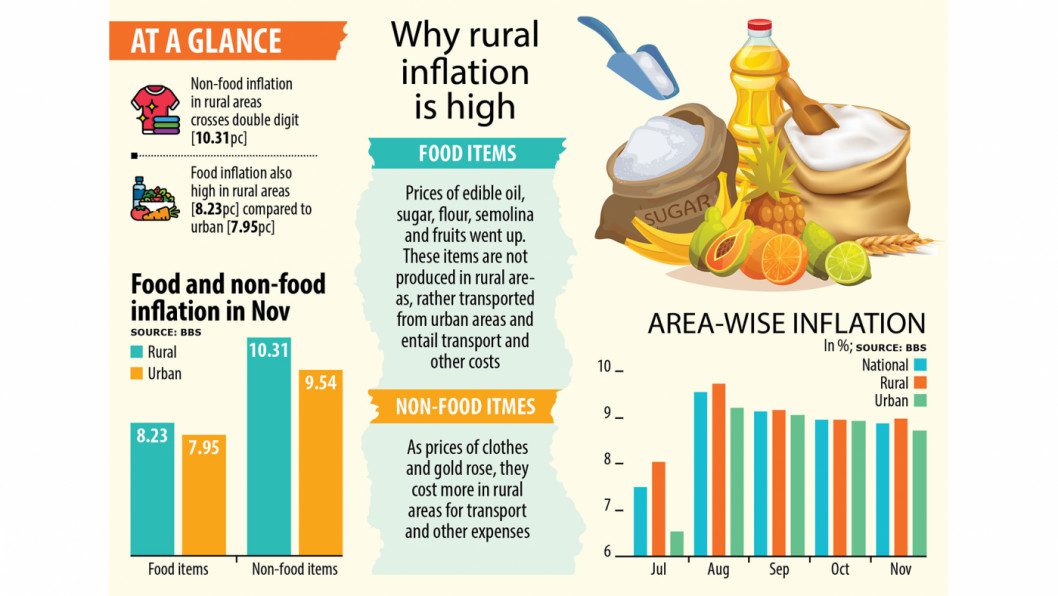Inflation falling, but not for rural people
Even though inflation has trended downward for the past three months, non-food inflation in rural areas increased to double digits last month. This is the first time this has happened in recent years, and it’s having a negative effect on those who are already struggling financially.
Inflation rates are still near 9 percent, which is much higher than what we’ve seen in the past. This is causing hardship for middle-income earners who are just trying to make ends meet.

While sharing monthly inflation data at a press briefing yesterday, Planning Minister MA Mannan stated that the government is not too concerned about the current situation people in the middle-income bracket are facing. He went on to say that the government is not in a position to focus on any initiatives for this segment of society at the moment.
“If the economy as a whole improves, those at the lower rungs of society will benefit the most,” said Mr.Ali, adding that this is for practical and political reasons – since the majority of our population still falls into that bracket.
Inflation eased down to 8.85 percent in November, as prices for most food items remained steady last month, showed data from the Bangladesh Bureau of Statistics (BBS) yesterday. This is lower than the 8.91 percent overall inflation in October.
November was the third consecutive month consumer prices underwent a downward trend. Inflation surged to a 10-year high of 9.52 per cent in August.
Addressing the media briefing, Mannan said inflation decreased in November while the wage rate grew which was a good thing.
The decrease in the inflation rate is slight but it is highly significant in economic terms, he opined.
The minister said it was a matter of joy that inflation had decreased globally except for a few economies during the same period.
“In each of the last three months I predicted that inflation would come down and it happened,” he said.
The wage rate has also gone up at the same time, said the minister, informing that the wage rate, which was 6.91 per cent in October, rose to 6.98 per cent in November.
Terming inflation going downward as good news for the economy, the minister said he believed inflation would surely come down further in December.
Mannan also mentioned that food production, including of rice and vegetables, had been satisfactory.
Stating that prices of oil and gas are coming down in the global markets, the minister said fuel prices may come down in the country too.
“Considering all these, I think not only the inflation or wage rate, but also the overall growth rate will reach the expected 7 per cent in the current fiscal,” Mannan said.
He hoped for the country’s economy to attain positive trends next fiscal year as it had been prior to the pandemic, even if the current condition of the Russia-Ukraine war prevailed.
Zahid Hussain, former lead economist at the World Bank’s Dhaka office, believes that a five basis points decrease in headline inflation is, at best, a pause in the increasing trend seen through September earlier.
“This has been possible due to a decrease in food inflation as winter crops have begun to enter the domestic food markets and there has been no further uptick in food import prices,” he said.
“The domestic demand containment measures put in place have not had any visible impact in slowing down the knock-on effects of supply side forces, like diesel price increases and exchange rate depreciation,” said the economist.
“This is not surprising because the demand containment measures have only been limited to austerity in government development expenditures,” he added.
“There is hardly any up-to-date data on the extent of compliance and the realized size of austerity,” he said.
“Managing livelihood for the rural and urban poor continues to be a difficult task as the growth in nominal wage for unskilled labor in all sectors falls short of food and non-food inflation,” he added.
Non-food inflation in rural areas reached 10.31% in November, up from 9.98% the previous month. Food inflation in rural areas stood at 8.23% in November, higher than the 7.95% seen in urban areas.
Ziauddin Ahmed, Director of the National Accounting Wing at the Bureau of Statistics (BBS), said at a briefing that rice and vegetable prices were cheaper in rural areas.















